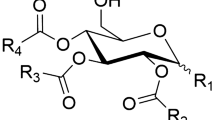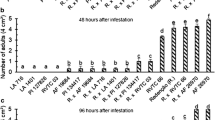Abstract
The tomato crop is of great importance, being the second most produced vegetable in the world. Among the factors that limit its production are the attack of pests and diseases. One of the alternatives for this problem is selecting more resistant genotypes to pests. In this sense, this research evaluated the relationship between acylsugar contents, types of leaf trichomes and resistance mechanisms in genotypes of the red mite (Tetranychus evansi). For this purpose, F2BC2 tomato genotypes with contrasting levels of acylsugars were submitted to the no-choice test and trichome count. Fourteen treatments, as well as the parental Solanum lycopersicum 'Redenção' (susceptibility-standard) and Solanum pennellii LA-716 (resistance-standard) were tested. As for glandular trichomes, the genotypes that presented the highest number of type IV trichomes were LA 716 and RVTA-232, and the lowest were RVTA-205, RVTA-376, RVTA-385 and 'Redenção'. For egg count, the lowest values found were in the LA-716 genotype and the highest values were RVTA-205, RVTA-227, RVTA-376, RVTA-385 and 'Redenção'. These results corroborate the evaluation of the number of trichomes presented, since the most resistant genotype and the most susceptible to the mites coincided with those with the highest and lowest number of glandular trichomes. The genotypes selected for high levels of acylsugars in the F2BC2 population showed a direct relationship with glandular trichomes density and enhanced resistance to the red mite, highlighting the genotypes RVTA-28, RVTA-39 and RVTA-232.







Similar content being viewed by others
References
Baldin, E. L. L., Vendramim, J. D., & Lourenção, A. L. (2019). Resistência de Plantas a Insetos: Fundamentos e Aplicações. Piracicaba, Brazil.
Catapan, V., Buzanini, A.C., De Moura, J.M.M., & Silva Santos, S. (2018). Principais pragas de hortaliças-fruto nas famílias das Solanáceas, Cucurbitáceas e Fabáceas. In. Hortaliças-fruto. Brandão Filho, J.U.T., Freitas, P.S.L., Berian, L.O.S., & Goto, R. (orgs.). EDUEM-UEM, Maringá-PR Brasil. https://doi.org/10.7476/9786586383010.
Da Costa, A. F., Fornazier, M., Bhering, L. L., Martins, D. D. S., Teodoro, P., Andrade, J. D. S., & Zanuncio Junior, J. S. (2017). Selection of strawberry cultivars with tolerance to Tetranychus urticae (Acari: Tetranychidae) and high yield under different managements. Genet. Mol. Res., 16(2). https://doi.org/10.4238/gmr16029599
Da Silva, A. A., Andrade, M. C., Maluf, W. R., Moraes, J. C., & Rezende, J. F. (2017). Resistance of tomato plant genotypes with high foliar allelochemical contents to the leafminer Liriomyza trifolii. Arquivos do Instituto Biológico, 84, e0892015.
De Oliveira, J. R., de Resende, J. T., Maluf, W. R., Lucini, T., de Lima Filho, R. B., de Lima, I. P., & Nardi, C. (2018). Trichomes and allelochemicals in tomato genotypes have antagonistic effects upon behavior and biology of Tetranychus urticae. Frontiers in plant science, 9, 1132. https://doi.org/10.3389/fpls.2018.01132
De Oliveira, J. R. F., Resende, J. T. V., Roberto, S. R., Silva, P. R., Rech, C., & Nardi, C. (2020). Tomato Breeding for Sustainable Crop Systems: High Levels of Zingiberene Providing Resistance to Multiple Arthropods. Horticulturae, 6(2), 34. https://doi.org/10.3390/horticulturae6020034
Dias, D. M., Corte, L.E.D., de Resende, J. T., Zeffa, D. M., de Resende, N. C. V., Zanin, D.S., & Filho, R. B. L. (2021). Acylsugars in tomato varieties confer resistance to the whitefly and reduce the spread of fumagine. Bragantia, 80, e4421. https://doi.org/10.1590/1678-4499.20210022
Dias, D. M., de Resende, J. T., Zeist, A. R., Gabriel, A., Santos, M. H., & Vilela, N. C. (2019). Resistance of processing tomato genotypes to leafminer (Tuta absoluta). Horticultura Brasileira, 37(1), 40–46. https://doi.org/10.1590/S0102-053620190106
Dias, D., Resende, J. V., Marodin, J., Matos, R., Lustosa, I., & Resende, N. (2016). Acyl sugars and whitefly (Bemisia tabaci) resistance in segregating populations of tomato genotypes. Genet. Mol. Res., 15, 1–11. https://doi.org/10.4238/gmr.15027788
FAO - Food and Agriculture Organization of the United Nations. FAO - FAOSTAT. (2021). Results of 2019. Accessed in: 19 feb. 2021.
Ferreira, D. F. (2014). Sisvar: a Guide for its Bootstrap procedures in multiple comparisons. Ciência e Agrotecnologia, 38(2), 109–112. https://doi.org/10.1590/S1413-70542014000200001
Gomes, A. C. S., Cardoso, M. G., Resende, J. V., Thomasi, S. S., Soares, L. I., & Ferreira, A. G. (2017). Acilaçúcares sintéticos e seu efeito no controle de artrópodes-praga. Ciência e Agrotecnologia, 41(2), 201–208. https://doi.org/10.1590/1413-70542017412031416
Gonçalves, L. S. A., Rodrigues, R., Sudré, C. P., Bento, C. S., Moulin, M. M., Araújo, M. L., Daher, R. F., Pereira, T. N. S., & Pereira, M. G. (2008). Divergência genética em tomate estimada por marcadores RAPD em comparação com descritores multicategóricos. Horticultura Brasileira., 26, 364–370.
Hammer, O., Harper, D. A. T., & Ryan, P. D. (2001). PAST: Paleontological Statistics software package for education and data analysis. Paleontologia Electronica, 4(1), 1–9.
Kim, J., Kang, K., Gonzales-Vigil, E., Shi, F., Jones, A. D., Barry, C. S., & Last, R. L. (2012). Striking natural diversity in glandular trichome acylsugar composition is shaped by variation at the Acyltransferase2 locus in the wild tomato Solanum habrochaites. Plant physiology, 160(4), 1854–1870. https://doi.org/10.1104/pp.112.204735
Kortbeek, R. W., Galland, M. D., Muras, A., van der Kloet, F. M., André, B., Heilijgers, M., et al. (2021). Natural variation in wild tomato trichomes; selecting metabolites that contribute to insect resistance using a random forest approach. BMC Plant Biology, 21(1), 1–19. https://doi.org/10.1186/s12870-021-03070-x
Lima, I. P., Resende, J. T., Oliveira, J. R., Faria, M. V., Dias, D. M., & Resende, N. C. (2016). Selection of tomato genotypes for processing with high zingiberene content, resistant to pests. Horticultura Brasileira, 34(3), 387–391. https://doi.org/10.1590/s0102-05362016003013
Lucini, T., Faria, M. V., Rohde, C., Resende, J. T. V., & Oliveira, J. R. F. (2015). Acylsugar and the role of trichomes in tomato genotypes resistance to Tetranychus urticae. Arthropod-Plant Interactions, 9(1), 45–53. https://doi.org/10.1007/s11829-014-9347-7
Luckwill, L. C. (1943). The genus Lycopersicon: an historical, biological, and taxonomic survey of the wild and cultivated tomatoes. Aberdeen University Press.
Maluf, W. R., Maciel, G. M., Gomes, L. A. A., Cardoso, M. G., Gonçalves, L. D., Silva, E. C., & Knapp, M. (2010). Broad-spectrum Arthropod resistance in hybrids between high- and low-acylsugar tomato lines. Crop Sci, 50(2), 439–450.
Moraes, G. J., & Flechtmann, C. H. W. (2008). Manual de acarologia: Acarologia básica e ácaros de plantas cultivadas no Brasil. Editora Holos.
Nakashima, T., Wada, H., Morita, S., Erra-Balsells, R., Hiraoka, K., & Nonami, H. (2016). Single-cell metabolite profiling of stalk and glandular cells of intact trichomes with internal electrode capillary pressure probe electrospray ionization mass spectrometry. Analytical Chemistry, 88(6), 3049–3057.
Navajas, M., de Moraes, G. J., Auger, P., & Migeon, A. (2013). Review of the invasion of Tetranychus evansi: biology, colonization pathways, potential expansion and prospects for biological control. Experimental and Applied Acarology, 59(1), 43–65. https://doi.org/10.1007/s10493-012-9590-5
Nelson, N. (1994). A photometric adptation of the Sommogy method for the determination of glucose. Journal Biology Chemical, 153(2), 375–380.
Nick, C.; Borém, A. (2016). Melhoramento de hortaliças. 1 ed. Viçosa: Editora UFV, 464p.
Pereira, G. V. N., Maluf, W. R., Gonçalves, L. D., Nascimento, I. R. D., Gomes, L. A. A., & Licursi, V. (2008). Seleção para alto teor de acilaçúcares em genótipos de tomateiro e sua relação com a resistência ao ácaro vermelho (Tetranychus evansi) e à traça (Tuta absoluta). Ciência e Agrotecnologia, 32, 996–1004. https://doi.org/10.1590/S1413-70542008000300045
Rakha, M., Bouba, N., Ramasamy, S., Regnard, J. L., & Hanson, P. (2017). Evaluation of wild tomato accessions (Solanum spp.) for resistance to two-spotted spider mite (Tetranychus urticae Koch) based on trichome type and acylsugar content. Genetic Resources and Crop Evolution, 64, 1011–1022. https://doi.org/10.1007/s10722-016-0421-0
Resende, J. T. V., Cardoso, M. G., Maluf, W. R., Santos, C. D., Gonçalves, L. D., Resende, L. V., & Naves, F. O. (2002). Método colorimétrico para quantificação de acil-açúcar em genótipos de tomateiro. Ciência e Agrotecnologia, 26(6), 1204–1208. https://doi.org/10.1590/S0100-204X2007000500013
Resende, J. T. V. D., Lima Filho, R. B. D., Ribeiro, L. K., Corrêa, J. V. W., Maciel, C. D. D. G., & Youssef, K. (2020). Strawberry genotypes with resistance to Tetranychus urticae mediated by leaf trichomes. Ciência e Agrotecnologia, 44. https://doi.org/10.1590/1413-7054202044006920.
Resende, J. T. V., Maluf, W. R., Cardoso, M. G., Faria, M. V., Gonçalves, L. D., & Nascimento, I. R. (2008). Resistance of tomato genotypes with high level of acylsugars to Tetranychus evansi Baker & Pritchard. Scientia Agricola, 65(1), 31–35.
Resende, J. T. V., Maluf, W. R., Faria, M. V., Pfann, A. Z., & Nascimento, I. R. (2006). Acylsugars in Tomato Leaflets Confer Resistance to the South American Tomato Pinworm, Tuta absoluta Meyr. Scientia Agricola, 63(1), 20–25.
Santos, N. C., Marquez, G. R., Maciel, G. M., Pereira, L. M., Peres, H. G., & Peixoto, J. V. M. (2020). Resistance of round tomato genotypes with determinate growth habit to two-spotted spider mites and silverleaf whitefly. Bioagro, 32(1), 15–22.
Saavedra, G., Spoor, W., & Harrier, L. (2001). Molecular markers and genetic base broadening in Lycopersicon spp. Acta horticulturae, 503-507. DOI: 10.17660 / ActaHortic.2001.546.69.
Savi, P. J., de Moraes, G. J., Melville, C. C., & Andrade, D. J. (2019). Population performance of Tetranychus evansi (Acari: Tetranychidae) on African tomato varieties and wild tomato genotypes. Experimental and Applied Acarology, 77(4), 555–570. https://doi.org/10.1007/s10493-019-00364-6
Schilmiller, A. L., Charbonneau, A. L., & Last, R. L. (2012). Identification of a BAHD acetyltransferase that produces protective acyl sugars in tomato trichomes. Proceedings of the National Academy of Sciences, 109(40), 16377–16382. https://doi.org/10.1073/pnas.120E7906109
Seki, K. (2016). Seleção assistida pela morfologia da folha para resistência ao ácaro- rajado Tetranychus urticae Koch (Acari: Tetranychidae) em cravos (Dianthus caryophyllus L.). Pest Management Science, 72, 1926–1933.
Smith, C. M. (2020). Conventional breeding of insect-resistant crop plants: still the best way to feed the world population. Current Opinion in Insect Science, 45, 7–13.
Stout, M. J. (2013). Reevaluating the conceptual framework for applied research on host-plant resistance. Insect Science, 20, 263–272.
Stout, M. J., Kurabchew, H., Leite, G. L. D. Host-Plant resistance in tomato (2018). Sustainable management of arthropod pests of tomato; Elsevier: Amsterdan, Netherlands, pp. 217–236.
Tiftikçi, P., Kök, Ş., & Kasap, İ. (2020). Biological control of twospotted spider mites [Tetranychus urticae Koch (Acari: Tetranychidae)] using Phytoseiulus persimilis Athias-Henriot (Acari: Phytoseidae) at different ratios of release on field-grown tomatos. Biological Control, 151, 104404. https://doi.org/10.1016/j.biocontrol.2020.104404
Toscano, L. C., Boiça-júnior, A. L., & Maruyama, W. I. (2002). Non-preference of whitefly for oviposition in tomato genotypes. Scientia Agrícola, 59(4), 677–681. https://doi.org/10.1590/S0103-90162002000400009
Vendemiatti, E., Therezan, R., Vicente, M. H., de Siqueira Pinto, M., Bergau, N., Yang, L., ... & Peres, L. (2021). Introgression of type-IV glandular trichomes from Solanum galapagense to cultivated tomato reveals genetic complexity for the development of acylsugar-based insect resistance. bioRxiv. https://doi.org/10.1101/2021.06.18.448858.
Vosman, B., van’t Westende, W. P., Henken, B., van Eekelen, H. D., de Vos, R. C., & Voorrips, R. E. (2018). Broad spectrum insect resistance and metabolites in close relatives of the cultivated tomato. Euphytica, 214, 1–14. https://doi.org/10.1007/s10681-018-2124-4
Zanin, D. S., de Resende, J. T. V., Zeist, A. R., de Lima Filho, R. B., Gabriel, A., Diniz, F. C. P., & Morales, R. G. F. (2021). Selection of F2BC1 tomato genotypes for processing containing high levels of zingiberene and resistant to tomato pinworms. Phytoparasitica, 49(2), 265–274. https://doi.org/10.1007/s12600-020-00852-1
Acknowledgments
The authors thank the National Council for Scientific and Technological Development (CNPq) and the Coordination for the Improvement of Higher Education Personnel (CAPES) for their contribution to the research.
Author information
Authors and Affiliations
Corresponding author
Ethics declarations
Conflict of interests
The authors declare that there is no conflict of interest.
Additional information
Publisher’s note
Springer Nature remains neutral with regard to jurisdictional claims in published maps and institutional affiliations.
Supplementary Information
ESM 1
(DOCX 529 kb)
Rights and permissions
About this article
Cite this article
de Souza Marinke, L., de Resende, J.T.V., Hata, F.T. et al. Selection of tomato genotypes with high resistance to Tetranychus evansi mediated by glandular trichomes. Phytoparasitica 50, 629–643 (2022). https://doi.org/10.1007/s12600-022-00984-6
Received:
Accepted:
Published:
Issue Date:
DOI: https://doi.org/10.1007/s12600-022-00984-6




